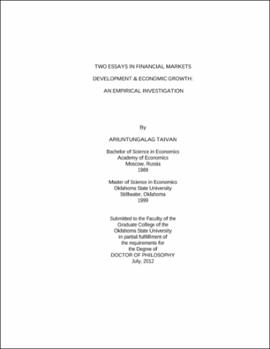| dc.contributor.advisor | Kim, Jaebeom | |
| dc.contributor.author | Taivan, Ariuntungalag | |
| dc.date.accessioned | 2013-11-26T08:23:35Z | |
| dc.date.available | 2013-11-26T08:23:35Z | |
| dc.date.issued | 2012-07 | |
| dc.identifier.uri | https://hdl.handle.net/11244/6724 | |
| dc.description.abstract | Scope and Method of Study: | |
| dc.description.abstract | The main purpose of this study is to investigate the relationship between financial development and economic growth and study the effectiveness of financial development for high income OECD as well as for group Asian economies with different income levels by using system approach. In conducting this study, ADF, KPSS, Johansen-Juselius (1991) cointegration test, Park's (1992) Canonical Cointegrating Regression (CCR), Error Correction Model (EMC), as well as Seemingly Unrelated Regression Error Correction Model (SURECM) and Granger (1969) causality tests in a system method are used as empirical evidence. | |
| dc.description.abstract | Findings and Conclusions: | |
| dc.description.abstract | We found the evidence that there are: 1) strong evidence that causality exists between the financial development and economic growth, more specifically, direction of causality is bidirectional in most of the cases; 2) evidence of positive causality running from finance to growth when DCBY is used as financial proxy, which highlights the importance of bank loan to promote investment and economic growth; and 3) a tendency of reverse causality running from growth to finance when LLY/BM is used as financial proxy, pointing out to the important role of formal bank intermediation for economic growth; 4) cases of one-way causality such as positive and reverse causality are more prominent for middle to low income countries; 5) an evidence that China has a huge impact on Asian economy and more precisely it has a significant impact on developing economies such as middle and low income countries; 6) selection of control variables does not affect the model specification and the direction of causality for Asian economies, however it is important variable for European sub-group; and 7) system method is superior to traditional regression methods. | |
| dc.format | application/pdf | |
| dc.language | en_US | |
| dc.rights | Copyright is held by the author who has granted the Oklahoma State University Library the non-exclusive right to share this material in its institutional repository. Contact Digital Library Services at lib-dls@okstate.edu or 405-744-9161 for the permission policy on the use, reproduction or distribution of this material. | |
| dc.title | Two essays in financial markets development and economic growth: An empirical investigation | |
| dc.contributor.committeeMember | Fain, J. | |
| dc.contributor.committeeMember | Applegate, M. | |
| dc.contributor.committeeMember | Carter, D. | |
| osu.filename | Taivan_okstate_0664D_12203.pdf | |
| osu.accesstype | Open Access | |
| dc.type.genre | Dissertation | |
| dc.type.material | Text | |
| dc.subject.keywords | causality | |
| dc.subject.keywords | cointegration | |
| dc.subject.keywords | economic growth | |
| dc.subject.keywords | error correction | |
| dc.subject.keywords | financial development | |
| dc.subject.keywords | seemingly unrelated regression | |
| thesis.degree.discipline | Economics | |
| thesis.degree.grantor | Oklahoma State University | |
